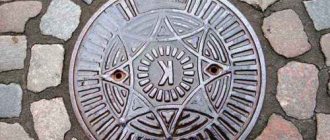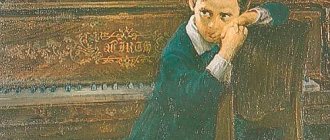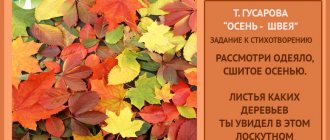Slide captions:
THE AMAZING WORLD OF STONES Responsible: teacher-speech therapist Statkevich E.O. educators Mashalgina G.P. Budantseva O.I. GBDOU kindergarten No. 34 2015
Goal: Expand knowledge about the variety of stones and their properties Objectives: Introduce children to the concept of “stone” Introduce children to the groups into which stones are divided Introduce children to the most famous stones - Introduce stone products
Stone - (Old Slavonic “kamy”). Hard mineral material (rock mass). Basically, rocks or precious stones (diamond, diamond, etc.) are called stones. They come from the Ukrainian “kamin” - “mountain”.
Stones are as integral a part of nature as plants and animals. But the world of stone is older than the living world. In Rus', rings with stones were worn in ancient times.
Belief in the mysterious magical power of precious stones has existed since ancient times, so they were purchased as amulets and talismans that protect against hostile forces and bring happiness, curing all diseases. The three main virtues of precious stones - beauty, durability, rarity - set them apart from the world of inanimate nature.
There are many different stones in the world in shape and size. Group I - precious stones (gems) diamond, ruby, sapphire, emerald, alexandrite, topaz, aquamarine, garnet, turquoise, rock crystal and others. Group II - ornamental (colored stones) jade, lapis lazuli, glavcolite, sodalite, amazonite, labradorite, rhodonite, azurite, malachite, jade, lapis lazuli, glavcolite, sodalite, amazonite, labradorite, rhodonite, azurite, malachite, gypsum. Group III - organogenic precious stones: pearls, coral, amber, jet.
The most famous of all stones is DIAMOND. Diamond - the name of the most famous precious stone comes from the Greek "adamos", which means irresistible or indestructible, and the Arabic "almas" - the hardest. The main distinguishing features of diamond are the highest hardness among minerals (but at the same time fragility). Jewelry-quality colored diamonds can be born in absolutely any color, tone, hue, saturation... The most common are lemon yellow and blue stones, less often - red, green, violet, purple... Even more rare - pink... The rarest are natural black diamonds, for Throughout the entire history of diamond mining, only a few hundred such stones have been found and documented... The first diamonds were found in India. From ancient Indian sources it follows that this happened about three thousand years BC. DIAMOND
DIAMOND PRODUCTS
Preview:
To use presentation previews, create a Google account and log in to it: https://accounts.google.com
2. The science that studies the physical and optical properties of precious stones is called gemology.
3. Absolutely all precious stones are mined by hand.
4. Prices for precious stones will only increase, because there are fewer and fewer real minerals on the planet.
5. 9/10 of all mined diamonds are used for production needs, and only 1/10 reaches jewelers and then consumers.
DIAMOND
6. Precious stones are quite complex in structure, with the exception of diamond. It is based on only one chemical element - carbon.
7. Depending on the shape of the diamond crystal, 55-70% of its weight is lost during processing.
8. The largest natural diamond ever found on our planet is the Cullinan diamond. Before division, its mass was 3106.75 carats (621.35 grams). In 1908, it was split into several large pieces, from which 9 large and 96 small diamonds were eventually made.
9. In 1694, Italian scientists John Averani and C. A. Tardgioni, while trying to fuse several small diamonds into one large one, discovered that when heated strongly, the diamond burned like coal.
10. Diamond will gradually transform into graphite if it is placed in a vacuum or in an inert gas at elevated temperatures.
ALEXANDRITE
11. Alexandrite is one of the few stones that changes its color. From green or blue (in daylight and sunlight) it becomes red or pinkish (in artificial light). Some garnets and sapphires behave in the same way.
12. Alexandrite was named after Tsarevich Alexander, the future Emperor Alexander II.
13. Different peoples of the world, living in different eras, treated emerald differently, but with equal respect. The ancient Greeks came up with a poetic name for it - the stone of radiance. Ancient Russians considered it one of the symbols of wisdom.
14. Indians traditionally presented emerald to newlyweds as a wedding gift, as they believed that it kept the spouses’ feelings “fresh” longer. 1
15. Emerald has long been considered a stone that protects its owner from damage. But our ancestors believed that it could only fully demonstrate these properties in a gold frame.
RUBIES
16.Ruby is considered a very rare and expensive stone.
17. At the same time, there is an entire ruby rock on the planet! It is located in Yakutia, but this huge thing may not be visible to the naked eye. The fact is that the rock is made up of tiny ruby crystals, which can only be distinguished under a microscope.
18. Ruby is a deep scarlet colored gemstone found almost everywhere. The only continent where its deposits have never been discovered is Antarctica.
19.95% of all rubies are artificially refined. Only truly large and perfectly beautiful stones can avoid such a fate.
20. Rubies and sapphires are the same stones. The only difference between them is the color. Rubies and sapphires are a variety of corundum. Red corundums are called rubies, blue ones are called sapphires.
21.The red color of ruby is given by an admixture of chromium, and the blue color of sapphire is caused by the presence of impurities of titanium and iron.
22.Traditionally, these stones are exported from Thailand, Tajikistan, Sri Lanka, Kenya and Tanzania. Rubies from Asia are considered the highest quality and, accordingly, the most expensive.
23. It is no coincidence that ruby is considered the royal stone. He was worshiped by many historical figures. Cleopatra, Cardinal Richelieu, Mary Stuart and Marie de Medici had their own collections of rubies.
24. And our contemporary - British Queen Elizabeth II - in 1973 ordered a luxurious ruby tiara from court jewelers. The jewelry was made from stones given to her by the Burmese as a wedding gift. And the entire jewelry collection of Queen Elizabeth II of England costs about $57 million.
EMERALD
25. Large, defect-free emeralds of a dense tone weighing from 5 carats are valued more than diamonds.
26. The largest emerald crystal was mined in 1974 in Brazil, its weight was 28 kilograms.
27. Aquamarine and emerald are the same stone, just the admixture of different chemical elements gives different colors. Chrome turns emerald green, and aluminum turns aquamarine blue.
28. Almost all emeralds have cracks and inclusions (according to various sources, 90–95%). But this does not reduce their value, because the stone is evaluated by color and saturation.
29. To extract just one carat of emerald, about 20 tons of soil are dug up in mines in Colombia.
30.The term "ornamental stone" refers to minerals and rocks that are used as inserts in jewelry or for the production of stone-cutting products. Sometimes less valuable or opaque stones are called ornamental.
GEMS
31. Gems are precious, semi-precious and ornamental stones that are used as jewelry and ornamental raw materials. They are usually transparent or translucent.
32. Sapphire is usually represented as a deep blue stone. In fact, purple, pink, orange, yellow and even green sapphires are found in nature, and are collectively known as “fancy” sapphires. The only color not available to this stone is red.
33. Boris Godunov valued sapphires very much. He considered them magical, with many beneficial properties.
34. Many people mistakenly believe that diamonds are only colorless. In fact, the color palette of a diamond can be the envy of any precious mineral. But nowadays, not all colored diamonds have natural color. Many stones are artificially colored. This is due to their rarity.
35.Before the invention of the Mohs scale (mineralogical hardness scale), stones were identified by color. So all the green stones became emeralds, the red ones became rubies, etc.
BLUE TOPAZ
36. Topaz becomes dull and discolored in the sun. Therefore, jewelry containing this stone is not recommended to be worn on the beach.
37. Of the colored topazes, the rarest is pink. It is very difficult to extract such stones.
38. And the most fashionable topaz is a delicate pinkish-powdery shade of Misty Rose.
39. In order to distinguish a real diamond from its imitation, a special “diamond probe” is used to measure the thermal conductivity of the stone being examined. Diamond has a much higher thermal conductivity value than its substitutes.
40. In addition, the good wettability of the diamond with fat is used: a felt-tip pen filled with special ink leaves a solid line on the surface of the diamond, while on the surface of the imitation it crumbles into separate droplets.
BIXBIT
41. There is a “red emerald” stone. In fact, it is a red variety of beryl, bixbite. This is an extremely rare stone and is mined only in Utah (USA).
42. Pink topaz is the rarest colored variety of this gemstone. It is pink topazes that are most often counterfeited.
TANZANITE
43. The largest known topaz is called Eldorado topaz. The weight of the stone, stored in Brazil, is 31 thousand carats.
44. If opals are stored in low humidity conditions, loss of moisture may cause them to crack and become cloudy. Therefore, jewelry and jewelry with opals should be worn as often as possible, since the gemstone can take the moisture it needs from the air or the skin of the person who wears it.
45. Cubic zirconia, an artificial material that imitates a diamond, is widely used in jewelry. Its cultivation occurs in laboratory conditions, where the crystal growth rate is up to 8-10 mm/h.
AMBER
46. Amber is the name of the resin of coniferous trees, which has lain in the depths for about 30,000,000 years.
47. Amber in the open air actively oxidizes (aging), which over time leads to changes in the chemical composition, color and increased fragility.
48. The largest amber deposit is the Kaliningrad region. The amber plant in the village of Yantarny produces about 90% of the world's production of this stone.
KREMLIN RUBY STARS
49. The Kremlin stars were originally made from Ural gems, which did not stand the test of time and harsh Moscow weather conditions and became dim.
50. In 1937, the Soviet government decided to install new stars - resistant to temperature changes, durable and not losing their color. A talented master, specialist glassmaker Nikanor Kurochkin compiled a recipe according to which a special glass was welded - ruby. It was from this that the shining red stars that decorated the Kremlin towers were made.
photo from the Internet
Slide captions:
TURQUOISE Turquoise is one of the most valuable opaque stones used in jewelry. The color of turquoise ranges from faded blue to bright sky blue, almost blue; from yellowish-greenish to almost green. Often turquoise has various inclusions of other minerals (usually black - psilomelane and brown - limonite - colors). Sometimes these inclusions are observed in the veins and are very numerous - this is a “turquoise matrix”. The color of turquoise is very delicate. When heated to just 250 degrees Celsius, the blue color of turquoise turns into a faded green (much less valued). Turquoise is afraid of sunlight, sweat, oils - yellowish spots may appear.
TURQUOISE PRODUCTS
MALACHITE Malachite is an opaque stone with a bizarre pattern of inclusions of all shades of green. The stone gets its name from the Greek “mallow” because its color resembles the color of the leaves of this plant. Pliny the Elder wrote that mala - hit is opaque, but denser and darker than emerald. However, the mineral is valued mainly for its varied texture: ribbon, streamy, concentric, radiant, star-shaped with iridescence. For the first time, a malachite deposit was discovered in ancient times in the Kirmana mountains in the south of Iran among copper mines. Deposits of “Elat stone” are located near the city of Elat in southern Israel. According to the Jewish legend, here once were “the mines of King Solomon.”
MALACHITE PRODUCTS
Preview:
To use presentation previews, create a Google account and log in to it: https://accounts.google.com
Card index of experiments with stones; experiments and experiments on the surrounding world (senior group) on the topic
Card index of experiments “Stones”
Experiments with stones Developed by: Boltalina O.V.1. What types of stones are there? Goal: to form an idea of the variety of appearance of stones, the properties of stones, to teach classification according to different characteristics. Materials: various stones, magnifying glasses. Course of experiment. Expected answers from children. Will you look at the stones carefully? What are they? Different. Big and small. Beautiful. Which stones do you like best? Find the most beautiful stones for you. Justify your opinion. Smooth and colorful. It has stripes on it. Round and small. Close your eyes and select the smoothest round pebble by touch. Look at it carefully. Do you know what it's called? This sea stone is called pebble. Why do you think it doesn't have sharp corners? Have there been before? I suggest taking a few pebbles in your palms and shaking them. What do you feel? Children choose a stoneChildren find it difficult to answer
How they knock. Why do they knock? Because we shake them. What happens to them at sea? (And what force shakes them in the sea?) They knock and fight there. By the power of water Water moves stones, pushes them against each other, and they rub against the sand. The sharp corners gradually grind down, the pebbles become round. Close your eyes and place your palms in front of you. (Places small rough pebbles in the children’s palms) How do you feel? What do the stones feel like?
Not smooth. Uneven, scratched. How do these stones differ from sea stones? Not smooth, sharp, rough. Lay out the stones in two rows: from large to small, from rough to smooth. Examine the pebbles through a magnifying glass. What do you see? Cracks. Patterns. What have we learned new about stones? Stones can be small and large, smooth and rough, colored and transparent, warm and cold.
2. Hard stone Purpose: To form an idea of the hardness of a stone Materials: pebbles, plasticine, coins Progress of the experiment Expected answers from children Take pebbles in one hand and plasticine in the other. Squeeze both palms together. Compare what happened to the pebble and what happened to the plasticine. Why? The plasticine is crumpled, but the pebble is not, because it is hard. Tap the lump of plasticine on the stone, two stones against each other. What is the difference? When they knocked with clay on a pebble, nothing was heard and the plasticine was washed, but when with two pebbles, a knock was heard and the stones did not wrinkle. Why do you think the noise was heard when pebbles were knocked on pebbles? Because the stone is hard, and the plasticine is soft. Scratch something on the stone with a coin. What happens? I can not see anything. The stone is very hard. Why do they say “hard as a stone”, “stands like a stone”? The stones are hard.
3. Sinking - not drowning Goal: to form ideas about the properties of a stone Materials: Sea pebbles, pieces of granite and pumice, transparent vessels with water. Course of the experiment Expected answers from children Children, what do you think will happen if you put a stone in water? He will drown. Throw a stone into a vessel of water and watch what happens to it. Drowned Can a stone float? No, take granite and pumice. Compare them by weight. Are the stones the same weight? No, one is light, the other is heavy. What will happen to each of them if you put them in water? They will drown. Let's check if this is true: put granite and pumice in water. What happened? The pumice did not sink, the granite did. Why do you think? Because pumice is light. There are a lot of holes in it. And in the holes there is air and air bubbles prevented her from drowning. Pumice has many holes in which air accumulates, so it is light and does not sink.
4. Can a stone make sounds? Purpose: to form an idea of the properties of a stone Materials: various stones Progress of experiment Expected answers from children Children, do you think a stone can make sounds? Maybe How can we check this? Knock pebbles Knock different pebbles against each other. Are the sounds that are produced similar? No. Heavy stones make a loud sound, small ones make a thin sound, and light ones make a quiet sound. Stones make sounds when they rub or come into sharp contact with each other. Different stones make sounds that are not similar to each other.
5. Do stones change color? Purpose: to form ideas about the properties of stones. Materials: empty containers, watering cans with water, stones. Course of experiment Expected answers from children Children, do you think stones can change color? No. Invite the children to put a stone in a container and fill it with water. Then touch the stones by feeling them in the water and pull the stones out of the water. What has changed? Compare stones by color: wet stones and dry ones. They became dark. Which of them is more beautiful? Wet. What conclusion can be drawn? Wet stones change color
6. Drawing stones Goal: to form ideas about the properties of stone. Materials: small sheets of plywood, chalk, coal. Course of experiment. Expected answers from children. Remember with the children what you can use to draw, for example, on asphalt. Which stones are best to draw on plywood: chalk or coal? Chalk Let's try to do this. Children draw on a plywood board with chalk and charcoal. What is the best way to draw? Why? It's better to draw with chalk because it's soft, but charcoal is hard - it scratches. Offer children a variety of stones for independent experimentation: pebbles, pumice, brick, coal Formulation of conclusions
7. Warm pebble Goal: to form an idea of the properties of the stone. Materials: lamp (sunny weather), pebbles of different colors (there must be a black stone) Progress of the experiment Expected answers from children Touch different stones and tell me, are they cold or warm? Cold Hold the stone in your fist. Has it become warmer? A little bit Why do you think? Our hands are warm. Take a white and black pebble and hold it under the lamp. (leave it in bright light) The pebbles became warm. Which stone became warmer? Black Why was the black stone the warmest? Children find it difficult to answer Black color absorbs the sun's rays. Therefore, the black stone heated up more than the white one. Remember, what clothes make us hotter in the summer?
In black
8. Light - heavy Goal: to form ideas about the properties of stone Materials: pebbles of different densities and sizes, scales. Course of experiment Expected answers from children Children, do you think it’s fashionable to look at stones and say which one is the heaviest? Can. The largest one will be the heaviest. And if you take pebbles of the same size, will they be equal in weight? So? Difficult to answer. Let's check. How can we do this? Take it in your hands Take pumice in one hand - a porous stone, in the other - a dense one of the same size. Which one is heavier? Why? Pumice is lighter because it has many holes; a dense stone has no holes, it is heavy. What do you think, if you take a large porous stone and a small dense one, which one will be heavier? Dense will be heavier Exactly? How else can we find out the weight of the stone. Exact weight? Using scales (children weigh stones on scales) Children, what conclusion can be drawn? Stones have weight. The weight of a stone sometimes does not depend on its size.
9. Durable stone Goal: to form ideas about the properties of stone Materials: stones of different densities, hammer The teacher suggests breaking the stones with a hammer One stone broke, but the other did not Which stone was easier to break The chalk we used to draw with, pieces flew off from it. Pumice is porous. What stone couldn’t be broken? Granite, pebbles Why? It is dense and heavy. Which of these stones is stronger? Granite and pebbles are stronger than chalk and pumice. Which of the stones that we looked at earlier are strong and which are less durable? Assume Marble is durable, limestone is not. What property of stone did we learn today? About strength







